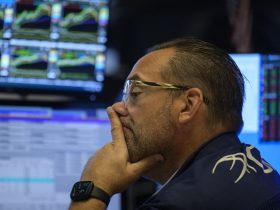For about 25 cents on the dollar, Ben Mackovak, a Cleveland-based investor, is diving into what he regards as one of the worst-performing Treasury bonds of all time.
It is the 30-year Treasury strip which matures in Nov. 15, 2049, and was sold at a discount when it was first issued on Nov. 15, 2019. The strips, which offer zero interest payments, had a yield to maturity of more than 5% when Mackovak bought them in October. They approach “at-par” or face value of 100 cents on the dollar as they progress toward maturity.
Bond investors have been witnessing the worst bear market for Treasurys in U.S. history, with long-term government debt undermined by repeated selling since 2020 because of a combination of higher inflation and interest rates from the Fed, U.S. economic strength, and heavy borrowing by the U.S. Treasury. That sent 10- and 30-year yields to 16-year highs last month — moves which have hammered existing bond holders and given new buyers like Mackovak attractive upside opportunities.
Read: Why bond-market investors are not panicking about the worst Treasury bear market in history
The 30-year Treasury strips purchased by Mackovak using a brokerage account — when the yield to maturity was 5.3% — are part of a careful calculation on his part. He’s betting on a hard landing in the U.S. and lower interest rates from the Federal Reserve within the next two years, and he’s factoring in what’s known as “convexity” — or the sensitivity of bond prices to interest-rate changes — into his thinking.
“My day job is not trading Treasurys, my day job is investing in U.S. banks,” said Mackovak, 42, co-founder and managing member of Strategic Value Bank Partners, a hedge-fund firm that oversees some $400 million in assets and runs four funds invested in community banks. He said he bought the 30-year Treasury strips, which now have 26 years left to maturity, as a personal investment and that they make up his largest single allocation outside of Strategic Value’s funds, though he declined to say by how much.
“What I see from our involvement in the banking system is that things are slowing down,” he told MarketWatch via phone. “The beauty of this trade is that if there is a hard landing, this trade makes potentially a lot of money. And if there’s not, you still earn a positive real return. I don’t have to be 100% confident to do this trade because of the risk-reward. I view it as a hedge to my equity exposure and other things.”
There’s no real cost to put on the hedge so “you get paid to wait because of the yield to maturity of 5.3%, and you have the potential to make 30%-70% if there’s a hard landing or long-term rates go down,” he said. “My plan would be to use it as a hedge against stocks and stock-price declines, and I view it as a 12- to 24-month trade.”
The 30-year Treasury strip that matures on Nov. 15, 2049, traded for around 50 cents when it was issued on Nov. 15, 2019, according to Lawrence Gillum, a Charlotte, North Carolina-based fixed-income strategist for broker-dealer LPL Financial. Now at roughly 25 cents, the strip has essentially lost 50% of its discounted value since its issuance four years ago, according to Bloomberg data this week.
The strip is close to some of the worst-ever performing U.S. bonds. The 30-year bond issued on Aug. 15, 2020, and maturing in the year 2050, is down by even more — around 61% — but “frankly all 30-year U.S. Treasuries that were issued during the summer of 2020 are down big,” Gillum said.
Any investor who purchased the November 2049 Treasury strip back in 2019 would have lost roughly 50% on the investment. But because Mackovak bought it in October, he’s counting on the 5.3% yield to maturity to produce a positive real risk-free return after subtracting inflation, and said he has enough “staying power” to hold on to the trade even if the Fed hikes further.
Bonds are generally considered to be a solid ballast for the portfolios of any investors who are expecting a recession. Expectations for economic downturns tend to create flights from risky assets into the safety of U.S. government debt, which then drives up bond prices. The risk of any potential losses is mitigated when strips are purchased at low prices, and an investor with a time horizon of one to two years can ride out any volatility without taking a big hit to potential income or profit, said one fixed-income director, who declined to be identified because he isn’t familiar with Mackovak’s trades.
According to Mackovak, the entire group of bonds trading at roughly a quarter on the dollar “should all behave the same way.” “I wanted to pick a spot and I was looking for the lowest face value, the highest yield to maturity, and the most convexity.”
“It seems more likely than not that we will get a hard landing, but what I like is that even if we are chugging along, this investment is still giving you a real risk-free return in Treasury bonds, which is something you haven’t been able to do in 15-16 years.” He said the real risk-free return would be around 2.3% or 3.3% before taxes, after subtracting an annual rate of inflation of 2%-3% from the 5.3% yield to maturity.
He’s not the only one who sees some bright sides to the bond market’s volatility. Jeff Sommer, a columnist for the New York Times who describes himself as a buy-and-hold investor, said trading in Treasurys “can be hazardous.” Nonetheless, he’s recommending standard Treasury securities ranging from one-month bills to 30-year bonds, which are “offering higher yields than investors have received in years,” and, while there might be better opportunities ahead, “this is already a good time to buy.”
Treasury strips are commonly held in indexes or funds overseen by big-name firms, such as Pennsylvania-based Vanguard and California’s Pimco. But at their current prices, Mackovak has jumped in because he figures that there’s a diminishing likelihood that he might incur any losses. “You need larger and larger interest-rate increases to create mark-to-market losses on these bonds.”
Read the full article here









Leave a Reply